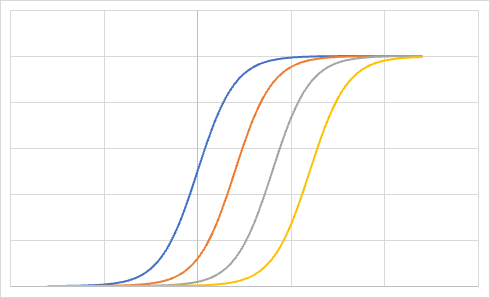
100s of Compounding "S-Curves": Why Exponential Progress will Continue Forever
Technological progress follows S-curves, with each innovation contributing to an accelerating and never-ending cycle of exponential growth.
If you follow this page, you are probably already a believer that the world has gone exponential. I wish it were as simple as asking anyone to acknowledge that there have likely been more advances in the last 10 years than in the entire century before. I wish I could instantly convey the sense that there's something new and exciting happening every week, perhaps even every day, and that what was considered cutting-edge just a few months ago is rapidly becoming outdated and, at times, even cringe-worthy. (If you don't believe me, go to this piece of published data from the US Patent Office: there have been twice as many patent applications between 2000 and 2020 as in the four decades before).
Then there is the inevitability of it all. How do we know if it will ever slow back again? Will it always be like this?
Like with any strong belief, they first hit us with an intuitive blow, and only after we have faith in them can we find the logical explanations for what we already know. How do you make an argument for exponentiality?
True exponentiality is not just about speed but about things getting ever faster. With the linear thinking we are accustomed to, it may seem hard to believe that there are no limits to how fast we can go.
Starting with something much simpler, something that can be experienced during a more intuitive timeframe, can help to understand what we are facing. I am referring to how individual technologies are introduced, something that we have seen many times in our lifetime. This is also a concept that I have caught Peter Diamandis mentioning almost in a throwaway fashion in many of his talks, usually as "hundreds of compounding 's' curves...". I think that the concept is so important that it deserves an article like this.
Most technologies take some time to develop and to become truly useful. Some, when first introduced, don't even have a use case that would help with their adoption, and even when products or solutions mature and have all the features needed, it takes them some time to go mainstream. As a result, the introduction of most technologies ends up following something like an "S curve" (or "sigmoid" for its mathematical function). The "technology hype" graph (with its typical shape shown below with a dashed line) is a slight variation, with an initial overshot accounting for the overexcitement and initial hype.

In the first phase, progress is slow, and it looks like nothing's happening, almost a failure, but then, something creates cloth, and the public starts to adopt the new technology. We enter the growth phase. At this point, progress seems almost linear and predictable. It is tempting to think that growth will continue at that trend. Many times, new ventures capitalize on this trend to predict exorbitant valuations and secure funding. Eventually, either because the market becomes saturated and the pool of new customers is depleted or because the success of the business attracts competitors, growth begins to slow down, and a "plateau" develops. With purely fad-driven innovations, there is even some kind of decline, but usually, if the technology has a true advantage and adds value, it stays around for much longer than after the headlines stop talking about it.
Now, I am going to make a leap. A small one, but still a leap. I will say that the overall benefits that technology provides to society at large follow an S-curve as well. No adoption, no benefit. Maximum adoption, maximum benefit. We can call this the "technology benefit" or "technology impact" curve. You may argue that there are some technologies that don't require a lot of people to adopt them to have an impact, but they still need to be adopted by a few users, and they will still have a period of no impact, and then, after a while, top impact.
Interestingly enough, technology introduction is not the only place where these types of curves come into play. They seem to be connected to a variety of natural processes. Actually, in the very definition of the sigmoid function on Wikipedia, this behavior is mentioned to be related to learning curves, crop yield, titration curves, etc.
But innovations don't happen in isolation. There are a number of technologies being adopted at any given time, at different stages in their cycle. In reality, you may have dozens or hundreds of these S-curves overlapping at different times. It is easy to accept that this is the overall approximate behavior of any technology's impact because we have seen it before. If we consider that there seems to be a new, smaller invention or improvement coming out all the time, we'll have something like the graph below.

So far, good? Alright! So here is what happens when these individual S-curves are added together to calculate the overall "technology impact":

This is without even considering that some technologies may have a larger impact than others (the curves in the example above all had a maximum plateau of one). Now, the first part of that curve looks way too much like an exponential, and it only plateaus out because I stopped adding "inventions" at four. According to this reasoning, as long as we keep coming out with small, incremental improvements, the result will never plateau out and will be a full exponential, going up and into the right, getting steeper and steeper all the time.
By this, if we accept our "S" curve model and that there are endless small innovations possible, then the world has gone exponential and will never go back to what it was. We will continue to see changes coming at us ever faster, continuing to accelerate. But what does this really mean for all of us? Can't we just get off the train? Jump off the treadmill?
I will address this in a future article of this two-part series.
#TechAdvancement #ExponentialInnovation #ScurveModel #RapidChange #FutureAcceleration #TechnologicalRevolution #InnovationImpact #UnstoppableProgress #FutureImplications #EmbracingChange

Weekly on Thursdays: Join our weekly ExO Networking calls by Registering here
Participate in the weekly ExO Masterminds sessions by Registering here
Immerse yourself in the game-changing ideas of OpenExO.
Begin your journey here 🎟️ExOPass & 📚Exponential Organizations 2.0
ExO Insight Newsletter
Join the newsletter to receive the latest updates in your inbox.









